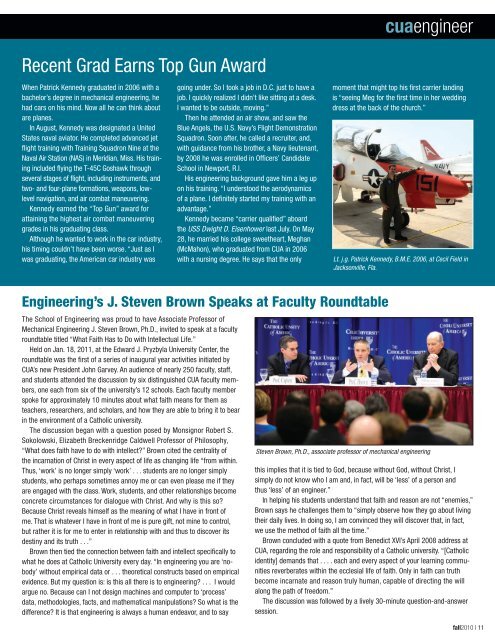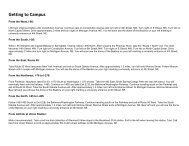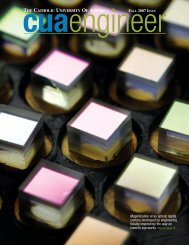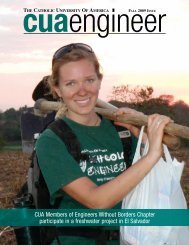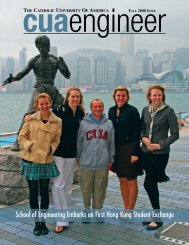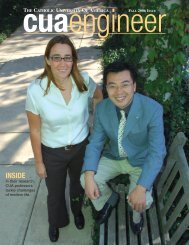Engineering New Frontiers Summer Camp - the School of ...
Engineering New Frontiers Summer Camp - the School of ...
Engineering New Frontiers Summer Camp - the School of ...
Create successful ePaper yourself
Turn your PDF publications into a flip-book with our unique Google optimized e-Paper software.
Recent Grad Earns Top Gun Award<br />
When Patrick Kennedy graduated in 2006 with a<br />
bachelor’s degree in mechanical engineering, he<br />
had cars on his mind. Now all he can think about<br />
are planes.<br />
In August, Kennedy was designated a United<br />
States naval aviator. He completed advanced jet<br />
flight training with Training Squadron Nine at <strong>the</strong><br />
Naval Air Station (NAS) in Meridian, Miss. His training<br />
included flying <strong>the</strong> T-45C Goshawk through<br />
several stages <strong>of</strong> flight, including instruments, and<br />
two- and four-plane formations, weapons, lowlevel<br />
navigation, and air combat maneuvering.<br />
Kennedy earned <strong>the</strong> “Top Gun” award for<br />
attaining <strong>the</strong> highest air combat maneuvering<br />
grades in his graduating class.<br />
Although he wanted to work in <strong>the</strong> car industry,<br />
his timing couldn’t have been worse. “Just as I<br />
was graduating, <strong>the</strong> American car industry was<br />
The <strong>School</strong> <strong>of</strong> <strong>Engineering</strong> was proud to have Associate Pr<strong>of</strong>essor <strong>of</strong><br />
Mechanical <strong>Engineering</strong> J. Steven Brown, Ph.D., invited to speak at a faculty<br />
roundtable titled “What Faith Has to Do with Intellectual Life.”<br />
Held on Jan. 18, 2011, at <strong>the</strong> Edward J. Pryzbyla University Center, <strong>the</strong><br />
roundtable was <strong>the</strong> first <strong>of</strong> a series <strong>of</strong> inaugural year activities initiated by<br />
CUA’s new President John Garvey. An audience <strong>of</strong> nearly 250 faculty, staff,<br />
and students attended <strong>the</strong> discussion by six distinguished CUA faculty members,<br />
one each from six <strong>of</strong> <strong>the</strong> university’s 12 schools. Each faculty member<br />
spoke for approximately 10 minutes about what faith means for <strong>the</strong>m as<br />
teachers, researchers, and scholars, and how <strong>the</strong>y are able to bring it to bear<br />
in <strong>the</strong> environment <strong>of</strong> a Catholic university.<br />
The discussion began with a question posed by Monsignor Robert S.<br />
Sokolowski, Elizabeth Breckenridge Caldwell Pr<strong>of</strong>essor <strong>of</strong> Philosophy,<br />
“What does faith have to do with intellect?” Brown cited <strong>the</strong> centrality <strong>of</strong><br />
<strong>the</strong> incarnation <strong>of</strong> Christ in every aspect <strong>of</strong> life as changing life “from within.<br />
Thus, ‘work’ is no longer simply ‘work’ . . . students are no longer simply<br />
students, who perhaps sometimes annoy me or can even please me if <strong>the</strong>y<br />
are engaged with <strong>the</strong> class. Work, students, and o<strong>the</strong>r relationships become<br />
concrete circumstances for dialogue with Christ. And why is this so?<br />
Because Christ reveals himself as <strong>the</strong> meaning <strong>of</strong> what I have in front <strong>of</strong><br />
me. That is whatever I have in front <strong>of</strong> me is pure gift, not mine to control,<br />
but ra<strong>the</strong>r it is for me to enter in relationship with and thus to discover its<br />
destiny and its truth . . .”<br />
Brown <strong>the</strong>n tied <strong>the</strong> connection between faith and intellect specifically to<br />
what he does at Catholic University every day. “In engineering you are ‘nobody’<br />
without empirical data or . . . <strong>the</strong>oretical constructs based on empirical<br />
evidence. But my question is: is this all <strong>the</strong>re is to engineering? . . . I would<br />
argue no. Because can I not design machines and computer to ‘process’<br />
data, methodologies, facts, and ma<strong>the</strong>matical manipulations? So what is <strong>the</strong><br />
difference? It is that engineering is always a human endeavor, and to say<br />
going under. So I took a job in D.C. just to have a<br />
job. I quickly realized I didn’t like sitting at a desk.<br />
I wanted to be outside, moving.”<br />
Then he attended an air show, and saw <strong>the</strong><br />
Blue Angels, <strong>the</strong> U.S. Navy’s Flight Demonstration<br />
Squadron. Soon after, he called a recruiter, and,<br />
with guidance from his bro<strong>the</strong>r, a Navy lieutenant,<br />
by 2008 he was enrolled in Officers’ Candidate<br />
<strong>School</strong> in <strong>New</strong>port, R.I.<br />
His engineering background gave him a leg up<br />
on his training. “I understood <strong>the</strong> aerodynamics<br />
<strong>of</strong> a plane. I definitely started my training with an<br />
advantage.”<br />
Kennedy became “carrier qualified” aboard<br />
<strong>the</strong> USS Dwight D. Eisenhower last July. On May<br />
28, he married his college swee<strong>the</strong>art, Meghan<br />
(McMahon), who graduated from CUA in 2006<br />
with a nursing degree. He says that <strong>the</strong> only<br />
<strong>Engineering</strong>’s J. Steven Brown Speaks at Faculty Roundtable<br />
cuaengineer<br />
moment that might top his first carrier landing<br />
is “seeing Meg for <strong>the</strong> first time in her wedding<br />
dress at <strong>the</strong> back <strong>of</strong> <strong>the</strong> church.”<br />
Lt. j.g. Patrick Kennedy, B.M.E. 2006, at Cecil Field in<br />
Jacksonville, Fla.<br />
Steven Brown, Ph.D., associate pr<strong>of</strong>essor <strong>of</strong> mechanical engineering<br />
this implies that it is tied to God, because without God, without Christ, I<br />
simply do not know who I am and, in fact, will be ‘less’ <strong>of</strong> a person and<br />
thus ‘less’ <strong>of</strong> an engineer.”<br />
In helping his students understand that faith and reason are not “enemies,”<br />
Brown says he challenges <strong>the</strong>m to “simply observe how <strong>the</strong>y go about living<br />
<strong>the</strong>ir daily lives. In doing so, I am convinced <strong>the</strong>y will discover that, in fact,<br />
we use <strong>the</strong> method <strong>of</strong> faith all <strong>the</strong> time.”<br />
Brown concluded with a quote from Benedict XVI’s April 2008 address at<br />
CUA, regarding <strong>the</strong> role and responsibility <strong>of</strong> a Catholic university. “[Catholic<br />
identity] demands that . . . . each and every aspect <strong>of</strong> your learning communities<br />
reverberates within <strong>the</strong> ecclesial life <strong>of</strong> faith. Only in faith can truth<br />
become incarnate and reason truly human, capable <strong>of</strong> directing <strong>the</strong> will<br />
along <strong>the</strong> path <strong>of</strong> freedom.”<br />
The discussion was followed by a lively 30-minute question-and-answer<br />
session.<br />
fall2010 | 11


